Measurement of Solar Reflectance for Roof Coatings and Materials using 410-Solar Reflectometer
- On September 23, 2014 TAGS: cool roofing
Surface Optics Corporation’s measurement division performed an in-house data comparison of the 410-Solar portable reflectometer vs. the Agilent Cary 5000 lab reflectometer. The purpose of this exercise was to evaluate the accuracy and performance of a portable reflectometer and compare it to that of a laboratory reflectometer for determining solar reflectance of sample roofing materials.
Recognition of the benefits of cool roofing has led to the adoption of cool roof requirements in local building energy codes, inclusion of cool roofing in green building initiatives, and made cool roofing the fastest growing sector of the roofing industry. This growing industry requires reliable performance data for the development and evaluation of its cool roof systems. Solar reflectance and thermal emittance are the two key material surface properties that determine a roof’s temperature, and they each range on a scale from 0 to 1. The larger these two values are, the cooler the roof will remain in the sun.
Reflectometers covering the solar spectrum provide a quantifiable method for evaluating and analyzing performance of roofing and coating materials when it comes to the fraction of solar energy that will be reflected by the roof. Traditionally, large laboratory reflectometers operating in this range have been used for testing during the manufacturing of materials that conform to cool roof standards. More recently, handheld portable reflectometers have been found to provide comparable solar reflectance data, with the added advantage of being easily carried onto buildings and around manufacturing facilities.
Solar Reflectance Measurement Tools
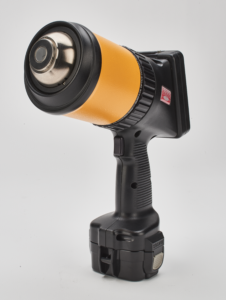
SOC410-Solar Reflectometer
Developed in collaboration with National Renewable Energy Laboratory (Cheryl Kennedy) for the evaluation of mirrors in the Concentrated Solar Power industry. The instrument design is based on the SOC 410-DHR (Directional Hemispherical Reflectance); a reflectometer developed with the U.S Navy for government applications. The 410-Solar is portable and modular, allowing for easy interchangeability between field use configuration and a lab setting configuration. It covers the 330-2500 nm solar spectrum measuring total, diffuse, and specular reflectance over seven discrete bands. It uses a modified integrating sphere with tungsten filament light source, and is NIST traceable through custom calibration references. See more specs here.
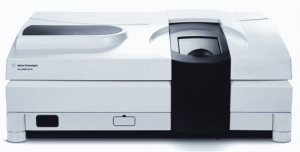
Cary 5000 Lab Reflectometer
Developed by Agilent and is a top-of-the-line laboratory reflectometer. For this test it was configured with a spectral resolution of 5nm covering the 330-2500nm solar spectrum. It also uses an integrating sphere, and was calibrated with NIST traceable Spectralon.
What is Solar Reflectance?
Solar Reflectance is the fraction of the incident solar energy which is reflected by the surface in question. The best standard technique for its determination uses spectrophotometric measurements, with an integrating sphere to determine the reflectance at each different wavelength. The average reflectance is then determined by an averaging process, using a standard solar spectrum. This method is documented by ASTM (Amer. Soc. for Testing and Materials) as Standards E903 and E892.
When this data is not available, other, less detailed measurements are utilized. The visible reflectance is sometimes measured by manufacturers. This is the reflectance in the visual part of the solar spectrum, wavelengths of 400 to 700 nanometers. Usually the visible reflectance is correlated with the solar reflectance, but the two quantities are not equal. For example, a good white coating with a solar reflectance of 0.8 typically has a visible reflectance of about 0.9.[1]
Equation for Calculating Solar Reflectance

- J(λ) is the solar irradiance function
- Ρd is directional reflectance
- the limits λ1 and λ2 are 300 nm and 2500 nm
Solar Reflective Paint and Coating Samples
Images of the coating samples that were measured for solar reflectance data by the SOC410-Solar and the Cary 5000.
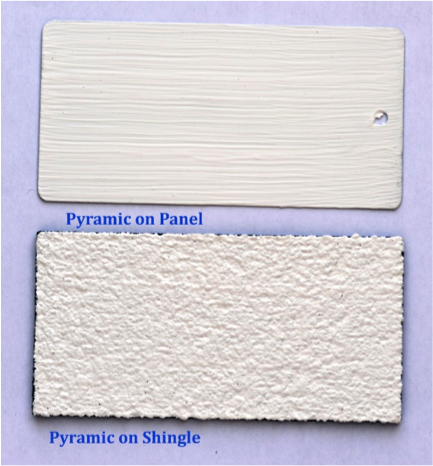
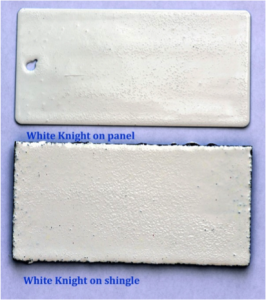
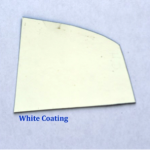
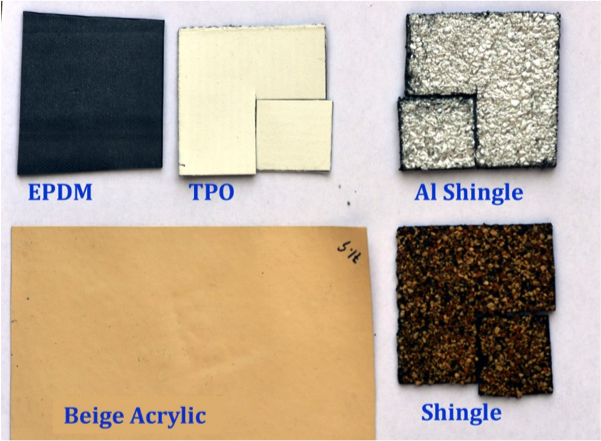
Portable reflectometer VS laboratory reflectometer
Total reflectance comparison between 410-Solar and Cary 5000 for all samples. Each sample was measured three times and reflectance values were averaged.
| Coating Sample | Cary 5000 | 410-Solar |
|---|---|---|
| White Knight Plus on Panel | 0.82 +/- .02 | 0.82 +/- .02 |
| White Knight Plus on Shingle | 0.80 +/- .02 | .80 +/- .02 |
| Pyramic on Panel | 0.82 +/- .02 | .80 +/- .02 |
| Pyramic on Shingle | 0.82 +/- .02 | .81 +/- .02 |
| White Coating | 0.84 +/- .02 | .84 +/- .02 |
| TPO | 0.77 +/- .02 | .76 +/- .02 |
| Beige Acrylic | 0.69 +/- .02 | .70 +/- .02 |
| Aluminized Shingle | 0.64 +/- .02 | .64 +/- .02 |
| EPDM | 0.16 +/- .015 | .15 +/- .02 |
| Shingle | 0.17 +/- .015 | .17 +/- .02 |
GRAPH OF CARY 5000 vs 410-Solar Data for Sample Material
Red line shows Cary 5000 spectral data compared with rectangles representing 410-Solar in-band data for the pyramic on panel coating sample.
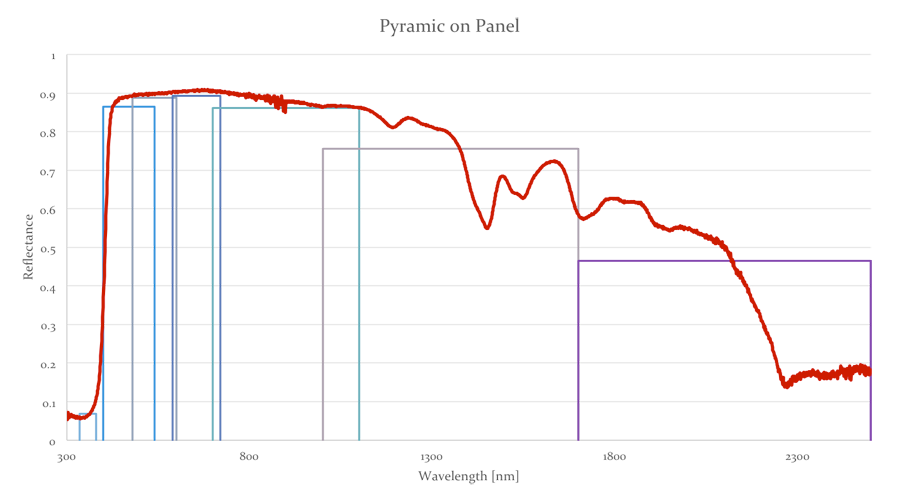
Final Result
In conclusion, the data produced by the two instruments was highly comparable. The difference in accuracy between the two instruments was no greater than 2% total reflectance. The 410-Solar’s performance in this test set was comparable to the more complex laboratory instrument.
Here are several advantages of the 410-Solar to consider when comparing to other portable reflectometers.
Modular design allowing for easy interchangeability between a handheld “pistol grip” field configuration and tabletop configuration.
Modified integrating sphere for increased accuracy.
Measures total, specular, and diffuse reflectance over 7 discrete bands–21 data points for each measurement.
Ruggedized touch screen PDA with user friend software interface and step-by-step calibration and measurement process. Data displayed immediately on PDA and can also be exported to spreadsheet.
Data and software stored on SDcard for safe storage.
True portability; uses a 12V Makita battery.
Our mission is to supply the highest quality instrumentation for measuring the optical properties of materials in research and commercial applications.
- 1. Lawrence Berkeley National Laboratory, (2014). Cool Roofing Materials Database – Definitions and Terms. [online] Available at: http://energy.lbl.gov/coolroof/ref_01.htm [Accessed 23 Sep. 2014].


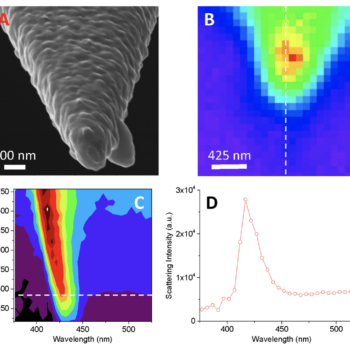
0 Comments